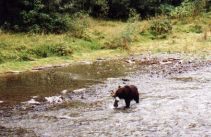 |
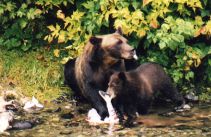 |
<<< Saturday, 1 August 1998
After washing mud and dust galore
from both the outside and inside of the car we started the 300 miles southerly
drive to
Whitehorse.
The brilliant purple Fire Weed is the first vegetation to appear after a fire
and we saw several good examples of this on the route. Vast areas of forest had
burnt several years ago but today the ground is covered in masses of purple Fire
Weed, with the remains of burnt trees still standing like black statues. At
Minto
which is about halfway, we stopped for the night in a delightful campground on
the edge of a crystal clear
Yukon River. During the gold
rush,
Minto was one of the stopping
points for the Stern Wheelers, plying between
Whitehorse and
Dawson City,
to take on more wood to fuel the boilers.
Sunday, 2 August 1998
Continuing our drive to
Whitehorse we noticed to our
surprise that the leaves on some trees were already starting to turn into their
autumn colours. Further on large areas of the forest were on fire with plumes of
smoke drifting for miles. Upon arrival, we checked our voice message service and
learnt that Dick & Pat were also in town. To our dismay, as we drove in the car
to their campground, we found that the car had yet again developed a vibration
problem. Spent the evening catching up on each other's news.
Monday, 3 August 1998
Most of the morning was spent
locating a facility to repair the car. It turns out that we need another set of
front wheel bearings and as expected it will take some days to obtain them.
Fortunately, the area has plenty to offer in the way of attractions while we
pass the time. The
Whitehorse Fishway has the longest wooden fish ladder in the
world. This is used by Chinook salmon to bypass the dam and reach their spawning
grounds, some 50 miles upstream. We watched a ranger fitting a radio marker to
one of the early arrivals as part of a programme to learn more about their
spawning habits. The run only started two days ago and will reach its peak
during the next two weeks, the sad part is that having swum 1947 miles up the
Yukon River during the past ten
weeks without eating, they all die shortly after spawning. What staggered us is
that only 600 or so salmon return each year. We then went back into town to
taste the beer at the local microbrewery, followed by a meal in the oldest
building in
Whitehorse.
Tuesday, 4 August 1998
Last night we agreed with Pat and Dick that it would be nice to travel together as we move further south. In the meanwhile, as it would be several days before the car was repaired, Pat and Dick left to spend a few days in Skagway. Talk about bolting the door after the horse has bolted. Having found that the car had been badly chipped by gravel along the Dempster Highway, George spent most of the day making and fitting a stone guard to the car.
Wednesday, 5 August 1998
To the 1898 gold rush stampeders,
Miles Canyon
was the last major natural obstacle before the comparatively easy 300-mile boat
ride to
Dawson City. The canyon
contained fearsome rapids which claimed many lives until the RCMP insisted that
an experienced pilot must accompany the boats through the canyon. We spent some
time trying to envisage the scene, since thousands of handmade boats, laden with
enough supplies to last a year, arriving shortly after the ice break-up, needed
to run the rapids. Today a dam has raised the water level in the canyon and
calmed the rapids somewhat, even so, it was easy to understand the enormous
difficulty they faced.
Thursday, 6 August 1998
Both of us spent the day
pottering around, which included removing more dust and mud from the RV as well
as a few repairs. Late afternoon we checked with Canadian Tyre and after some
hesitation, they informed us that the bearings for the car had arrived, they
would fit them tomorrow.
Friday, 7 August 1998
Took the car in for the bearings to be fitted,
however, they discovered an oil leak which turned out to be the engine's main
oil seal. This would take seven hours to replace but as usual, they do not have
the part. To make it worse they have created a new problem since the ABS no
longer works. Decided to sleep on the problem. The nearest Suzuki dealer is in
Prince George, BC which is 950
miles away! Late afternoon Dick and Pat returned from their three-day visit to
Skagway. We both wanted to travel down the west coast of Canada
since by all accounts the route along the
Cassiar Highway was one of the most scenic in Canada. However,
according to fellow travellers, the 446-mile highway was 30 per cent gravel and
most of that was being ripped up. After much hesitation we decided to take a
chance, hoping that it would be dry, leaving only dust to contend with.
Saturday, 8 August 1998
By late afternoon and after 265 miles we camped for the night at the junction of route 37, which is the decision point for taking the Cassiar Highway. We will decide which route to take in the morning. During the evening we watched numerous vehicles having just travelled the highway, passing our campground, they were covered in mud from end to end. It is not a good sign. However, today’s drive was uneventful, just miles and miles of attractive scenery, in particular lots of lakes set in spruce forests.
Sunday, 9 August 1998
The weather was not too good by
the time we were ready to leave but we decided to risk travelling along the
Cassiar Highway. We encountered
about 30 miles of poor road and with the steady drizzle, the rigs were soon very
dirty. Half way we stopped at
Jade City which claims to
have the best and cheapest jade in the north which meant that Pat & Valerie had
to have some. We camped at
Dease Lake for the night
which fortunately had a pressure washer which was put to good use. Having moved
a long way south during the past week the sun now sets at a more normal time for
us.
Monday, 10 August 1998
It was 245 miles to
Stewart so it was an early
start and a long day because of the poor condition of the road. About half the
road was gravel but fortunately, it remained dry and yesterday's rain kept most
of the dust down so we could concentrate more on enjoying the scenery, which was
excellent. It was an ever-changing landscape, desolate countryside with numerous
lakes, rivers, and spruce trees for mile after mile. The final part of the road
goes through
Bear Pass which cuts through the coastal mountain range,
with twenty hanging glaciers visible from the road.
After a good value evening meal
in the Bitter Creek Cafe, we drove a few miles north, crossing the US border
into
Hyder,
Alaska.
Hyder appeared to be a bit of a
ghost town, which we decided to explore another day since we were more
interested in travelling a few miles further north along the
Salmon River.
The gravel road soon led to
Fish Creek where we were
amazed to see countless salmon in the shallow water. These were 20 to 40 lb.
Chum Salmon and the bed of the creek were their spawning ground. Many were
already paired up, some males were still fighting for a partner, whilst numerous
other fish had already died after mating. In some ways, it is a sad sight and
seemed such a waste.
All of a sudden we spotted a
grizzly bear walking up the creek towards us. If it had not been for the Park
Ranger we would have all scattered to our cars. Surprisingly the rangers do not
carry guns, relying on pepper spray as their only form of protection. In no time
we were only 15 feet from a wild grizzly bear, with nothing in between to
protect us. It was very exciting and we felt privileged to see it but the
experience also made one's hair stand on end - well those who have some!
What a spectacular day it turned
out to be and was perfect for George’s birthday. Just after 6 a.m. the four of
us arrived at the Chum Salmon spawning grounds, where about five other early
birds were already there, as well as two Park Rangers. Within a few minutes, a
four-year-old grizzly bear appeared out of the forest and ambled into the creek.
As it walked upstream hundreds of salmon desperately swam in all directions
trying to get out of the way but for some, it was to no avail. About 45 minutes
later a large mother and baby cub appeared and started to walk down the gravel
road towards us. This had us scattering in all directions since she was acting
nervously, worried that a male bear might attack her cub. After a while, the two
bears stopped in the creek directly opposite us and slowly selected a salmon
from the many on offer. The mother seemed to be teaching the cub how to choose a
fish and the best way to eat it.
 |
 |
We watched for another hour or so, went for breakfast and then set off along the Granduc and Salmon Glacier road, which turned out to have the most spectacular scenery. About halfway along we had our first glimpse of the magnificent Salmon Glacier. The glacier extends for miles as it flows down the mountain and must be over a mile in width. From a high vantage point further on we could see countless deep crevasses in the ice, making it impossible to traverse. It was a fascinating and wondrous sight. Further, on is the self-dumping Summit Lake, which once a year suddenly empties when in mid-summer the ice melts, normally flooding the surrounding area. It had recently emptied leaving large icebergs stranded all over the muddy lake bottom. We stopped and stared while we had a picnic lunch and George thought he had gone to heaven when he tasted the cinnamon buns we had purchased from the local bakery. A note was made to buy some more before we leave Hyder
 |
 |
At the end of the road are the
remains of a vast copper mine which reminded us of the country's vast mineral
wealth. This is a modern mine ruin, without the charm of some other abandoned
mines we have seen, but it is huge. It seems to be a waste to knock down the top
levels and leave the rest to self-decay.
|
It rained all night and remained damp and overcast during the morning, so we spent some time in the local museum and then walked around Hyder, which is an odd place. Many of the buildings date back to the turn of the century and some are poorly maintained. You can only claim to have properly been to Hyder when you have been Hyderized. This entails a visit to the local bar and drinking an ounce of an unknown liquor straight down, we decided to pass. Being fascinated by the bears we made two further trips to Fish Creek and on both occasions, we were lucky enough to see a bear. |
||
|
|
|
Today’s destination was the City
of
Prince Rupert,
some 285 miles to the south. As we left
Stewart
the clouds were low and drifting in long wispy layers through the valley, which
looked delightful. We spotted a bear about one hour into the journey and shortly
afterwards stopped in the Indian village of
Kitwancool to see a display
of the most enormous totem poles. Some were over forty feet tall, all had
various animals, figures and patterns carved on them. Originally totem poles
were used as symbols to welcome visitors to the village. For the last 150 miles,
the road followed the
Skeena River valley but low clouds prevented us from seeing
the scenery at its best.
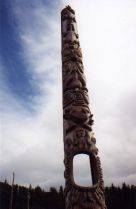 |
 |
Friday, 14 August 1998
Constantly visiting new places is
very enjoyable but does have a downside when it comes to finding a particular
shop or in this case repair facility. Yesterday, on the way into
Prince Rupert the RV exhaust
developed a leak, which was getting very noisy. After some searching, we
eventually tracked down a small repair shop. As usual, they did not have the
correct gasket, however, like many small-town mechanics, he was a good
improviser and soon had the job done. As the car oil leak appears to be getting
worse, we phoned ahead for a service booking but learnt that there were no oil
seals available and they were not sure when they could obtain one. As we have
only 200 miles left before the warranty runs, we will visit the dealer in
Prince George's next week and
hopefully come to an agreement.
For most of this century, the
local area was the centre of a major fish canning industry, with dozens of
canneries located along various rivers. One of the major canneries on the
Skeena River is now a museum,
which we spent a few hours touring. At its peak, hundreds of low-paid workers
from many races were employed. Each race lived in separate company housing
communities within the cannery which enabled the management to more easily
exploit them.
 |
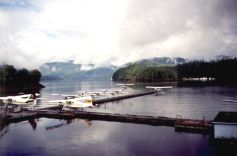 |
We set off for
Smithers 240 miles to the
south and about halfway to
Prince George.
However, when we stopped to see the Historical Indian Village at
Ksan we decided to stay
overnight on discovering they were holding a Pow Wow nearby. We watched the
gathering for some time as it was a beautiful sunny afternoon and the
traditional music and colourful costumes were a delight. One elderly Indian
impressed us with the proud and elegant way he carried out several traditional
dances. Pat was brave enough to buy a seaweed, clam and rice dish, which looked
awful but surprisingly, tasted good. We have now travelled a long way south so
not only is the sun setting during the early evening but we can also pick up
satellite TV again. President Clinton’s problems still seem to be the main news.
On checking later, we were surprised to find that our latitude is already south
of London. Reading cowboy poems around the campfire nicely finished the day.
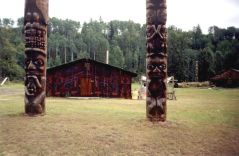 |
 |
|
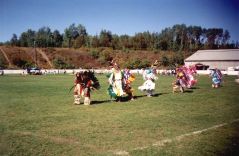 |
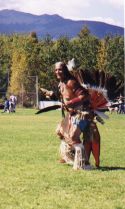 |
Monday, 17 August 1998
A long eight-hour and fairly
uninteresting drive took us to the large town of
Prince George.
It’s not fair to say the scenery was uninteresting but in comparison to that of
the past few months, it was less dramatic. Tomorrow the Suzuki is booked in for
repair which provided the stimulus to spend some time giving the car a long
overdue spring clean.
It takes 10 to 14 days for mail to reach the Far North and since we have not been able to plan that far ahead, we have not had any mail for the past three months. As we were getting anxious about what may be waiting for us etc. we decide to have the first class mail sent by Federal Express to Prince George. The mail was waiting for us when we arrived at the campground so we had a pleasant time catching up on the news and then some time complaining about the bills.
Tuesday, 18 August 1998
The car problem was confirmed to
be a leaking engine oil seal and a faulty ABS wheel sensor and as usual, they do
not have the parts. This means we will need to plan about one week ahead so that
the service centre has time to obtain the parts - hopefully! George has become
accustomed to spending hours waiting in the service department, so he put the
time to good use by taking the PC along and writing the travelogue etc. The rest
of the day was spent odd jobbing.
| Shortly after leaving Prince George, we were surprised to come across a large herd of grazing buffalo. Further on we diverted to spend a day in Barkerville, which is a historic gold rush town in British Columbia. The town was born in 1862 when Billy Barker, a Cornish miner first found gold in large quantities but it became a virtual ghost town when the gold ran out after the turn of the century. | ||
|
Today the ghost town
still contains 125 of the original or reconstructed buildings including
the Barkerville Hotel, St. Saviours Church, the Mason and Daly General
Store and the Wake-Up Jake Cafe. Board sidewalks and dirt streets help
preserve the flavour of the original site. We were able to recapture a
little of the atmosphere of the early years since many of the town's
characters were in period costumes. Late afternoon we watched an
entertaining period melodrama in the Theatre Royal, followed by a meal
in the old town bar. The day closed with the girls winning their first
game of Pegs and Jokers! |
|
|
|
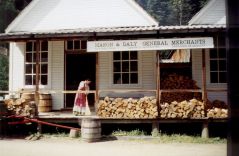 |
|
Thursday, 20 August 1998
Another long day's drive, during
which the scenery changed from rich farmland to a high arid desert landscape. On
arriving at
Spencers Bridge
we were surprised to find that the temperature had shot up and even at 6.00 p.m.
it was 94F. In no time we changed into our shorts for the first time in several
months. We camped on the side of the
Frazer River which rises in
the
Rocky Mountains
as does the nearby
Thompson river; both of which are world-famous for Steelhead
trout, bringing fishermen from all over the world from October to December.
The drive south from
Spencers' Bridge through the
Frazer River canyon to the town
of
Hope
and beyond is spectacular. For the most part, the fast-flowing river flows
through an arid deep canyon. Railway lines cling to the mountain on both sides
close to the river, with the road high above, providing excellent views. The
nearly mile-long trains looked like dinky toys as they dragged their 100-plus
rail cars along steep grades. The canyon narrows considerably at
Hells Gate where we stopped
to take the cable car ride across the river. When a second railway line was
built, thousands of tons of blasted rock almost blocked the river, which killed
millions of returning Sockeye salmon as they tried to reach their spawning
grounds. In an attempt to restore the Sockeye run to its former level, several
vast fish ladders were built in the 60s but even today the numbers have not
fully recovered.
 |
 |
|
 |
 |
After camping at
Rosedale we visited the
nearby
Minter Gardens
during the afternoon. Set against a magnificent mountain backdrop the gardens
are a riot of colour and imaginatively laid out. Themes such as Victorian floral
ladies and a giant strutting floral peacock, add uniqueness to the garden. With
some puffing and panting, we then climbed about 600 feet to the base of Bridal
Falls, whose waters cascade down the mountain in a mass of small streams,
producing a bridal veil effect.
Saturday, 22 August 1998
After travelling together for
some weeks we said a sad farewell to Pat & Dick who were heading home while we
turned our attention towards visiting
Vancouver and its Island. It
was time to have a rest from RV travelling, so we decided to stay in
Rosedale for an extra day.
During the morning we tried to locate Barbara and Eric, the Ex Brits whom we met
some time ago in California and who live in nearby
Chilliwack. However, having
found their beautiful house we were told they had moved some two months ago and
were now living somewhere in their motor home whilst a new house was being
built.
Sunday, 23 August 1998
It was only 60 miles or so to
Vancouver but for the first time
in some months, we encountered fairly heavy traffic, which took some adjusting
to. We have now stayed at about 250 campgrounds but everyone is different and
today’s was no exception and somewhat special. The drive-in, office and grounds
are covered in a mass of flowers of every description, it is almost like staying
in a flower garden. The eyesore of most campgrounds is the wastewater dump but
here it is cleverly screened by flowers and colourful hanging baskets.
| Vancouver has numerous attractions so we left fairly early to explore. Our first stop was Granville Island which is a mixture of maritime and industrial history, shops and restaurants all surrounded by the shores of False Creek. Many of the old industrial buildings have been converted into everything ranging from craft stores to art studios. We wandered the area for some time in beautiful sunshine and ideal temperatures. The market was a hive of activity, full of fresh produce, bake shops, seafood and speciality shops. | ||
 |
After lunch, we drove to the cable car lift at the base of Grouse Mountain and 10 minutes later we were looking over the City of Vancouver, which is surrounded by mountain ranges in all directions. Back down it was then off to the Capilano Suspension Bridge which is the world’s greatest suspension footbridge being 230 feet above and 450 feet across the Capilano River. Talk about sway as we walked across, it was lucky it was not windy since it was moving so much as we walked across that we had to hold on to the handrail for most of the way. | |
Tuesday, 25 August 1998
Time for overdue haircuts for both of us and then we relaxed enjoying the pleasant campground.
Wednesday, 26 - Monday, 31 August 1998
pleasant campground, delightful
weather and feeling the need to have a rest from nearly three years of
travelling we decided to stay put for a while. Valerie found several good books
in the campground library and George was delighted since the campground has a
free phone hook-up. So he was able to surf the Net, between car and RV
maintenance and cleaning.